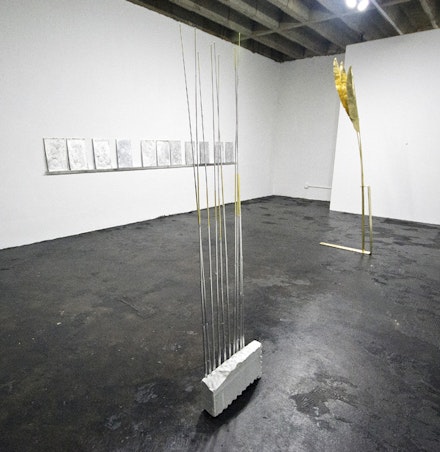ArtSeen
ELAINE CAMERON-WEIR Not Known To Be Used By Any Form Of Life
In their materiality and seriality, the cast metal slabs lining the wall of Elaine Cameron-Weir’s current solo show evoke the processes and principles of 1960s post-minimalism. With imperfect symmetry, rippled surfaces, and cracked edges, the slabs bear the impression of a crude mold and evidence their own making; as supple rectangles grouped in sequence, they recall the process-based work of Eva Hesse and Richard Serra. Cast in solid aluminum, the slabs were poured from melted scrap metal, which Cameron-Weir culled from a junkyard in her native Canada. Displayed in a Lower East Side gallery, they elicit also the work of Robert Smithson, his fascination with provisional sites and landfills, and his theories of displacement—the psychological and physical distance between a material and its site of origin.
On View
Ramiken CrucibleApril 1 – May 13, 2012
New York
Smithson’s earthworks and sculpture questioned the notion of progress, and his practice was dedicated to demonstrating collapse, erosion, and the inevitability of decay. In a brilliant twist on process-based sculpture, Cameron-Weir composes her slabs in a material that defies degeneration and loss—aluminum can be reconstituted over and over. It’s a metal that does not corrode, and it is one hundred percent recyclable, ubiquitous in canning and numerous other consumer and commercial purposes. Aluminum is also instrumental to industry, particularly to the building of airplanes, missiles, and spacecraft. The material and its manipulation are central to the meaning of Cameron-Weir’s sculptures: The exhibition title not known to be used by any form of life comes directly from the element’s definition on Wikipedia.
In many ways, Cameron-Weir’s entire exhibition rejects the pervasive perception of decline, looking instead to an idealized and imagined future. Like the protagonist in Joris-Karl Huysmans’s Against Nature (1884), who renounces his environment and retreats to an artificial world of his own design, Cameron-Weir has fashioned her work from a vision post-nature. Her elegant, towering, 12-foot houseplant, “Palm” (2012), is made entirely of brass, and its cool austerity lends an air of space-age science fiction. It could have been fabricated for a 1980s film set in post-apocalyptic Miami, styled before a window with venetian blinds, thriving without oxygen or water. “Time Zones Radio Waves” (2012), a bamboo-like sculpture in alternating metals, also embodies anachronism, its aluminum and brass plant stalks converging into ball-capped telescoping antennae. The sculpture appears to have been made from a decades-old perspective, conceived before technologies went digital, when mass communication signals were transmitted by waves and frequencies.
Despite their pop-culture potential and sci-fi attributes, Cameron-Weir’s sculptures belie any comparison to props or set pieces. On the contrary, their craftsmanship is exquisite, and they are in no way provisional—the antennae of “Time Zones Radio Waves,”for example, are set cleanly in a base of solid white marble. “Palm”has a formal uplift, warm polish, feather shape, and oblong curvature that must take Brancusi’s indelible “Bird in Space” (1923) into consideration. Cameron-Weir’s works speak assuredly to the history of 20th-century sculpture, evincing a brightness and confidence. It’s impressive to see such a young artist pull from modern and postmodern styles with discernment, realizing a body of work that stands starkly on its own.


